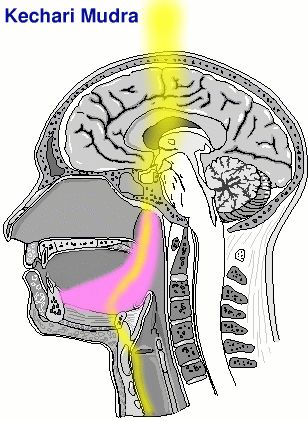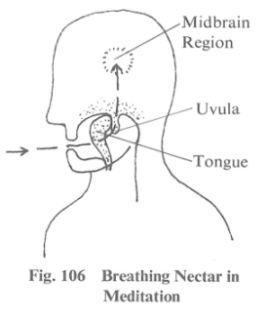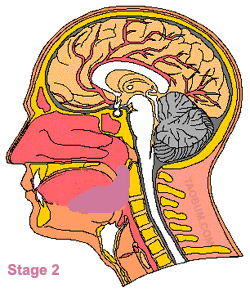
 The Kechari Mudra and Prem Rawat's Meditation Techniques
The Kechari Mudra and Prem Rawat's Meditation Techniques
 The K(h)echari Mudra is a yoga position in which the tongue is placed back and up the nasal cavity. It is believed to have many positive effects but ordinarily cannot be achieved without cutting the frenulum linguae, or lower tendon of the tongue, so that the tongue can actually extend back and up into the root of the nasal cavity. This is not something to be done lightly and was never recommended in Divine Light Mission as it was claimed that with continual practice it could be achieved and the Divine Nectar could then be drunk. I have never heard of any follower of Prem Rawat's achieving this and he made it redundant in 1987 when he defined the 4th technique, no longer to be called the Divine Nectar, to be the nabho mudra as it only requires turning the underside of the tongue up; press it against the hard palate; extend the tip of the tongue back towards the soft palate. Michio Kushi taught a similar technique in The Book of Do-In.
The K(h)echari Mudra is a yoga position in which the tongue is placed back and up the nasal cavity. It is believed to have many positive effects but ordinarily cannot be achieved without cutting the frenulum linguae, or lower tendon of the tongue, so that the tongue can actually extend back and up into the root of the nasal cavity. This is not something to be done lightly and was never recommended in Divine Light Mission as it was claimed that with continual practice it could be achieved and the Divine Nectar could then be drunk. I have never heard of any follower of Prem Rawat's achieving this and he made it redundant in 1987 when he defined the 4th technique, no longer to be called the Divine Nectar, to be the nabho mudra as it only requires turning the underside of the tongue up; press it against the hard palate; extend the tip of the tongue back towards the soft palate. Michio Kushi taught a similar technique in The Book of Do-In.
These positions are considered by some to be amongst the deepest esoteric, spiritual knowledge known to man and by others to be complete nonsense. It is unlikely that Rawat ever learnt (and certainly never practised) any of the yoga on which the meditation techniques his father taught were based. He has disparaged other theories as riff-raff, admits he cannot understand kundalini or chakras and says the basic meditation techniques he teaches are Raj Yoga, "the King of all Yogas", The Yoga of all the yogas. The Knowledge of all the knowledges.




In his book "Waking Up… A Guide To Spirituality Without Religion" Sam Harris, the avowed and articulate atheist author, discusses Arthur Koestler's Journey to the East:
It is easy enough to find fault with romantic ideas about Eastern wisdom, and a tradition of such criticism sprang up almost the instant the first Western seeker sat cross-legged and attempted to meditate. In the late 1950s, the author and journalist Arthur Koestler traveled to India and Japan in search of wisdom and summarized his pilgrimage thus: "I started my journey in sackcloth and ashes, and came back rather proud of being a European."7
In The Lotus and the Robot, Koestler gives some of his reasons for being less than awed by his journey to the East. Consider, for example, the ancient discipline of hatha yoga. While now generally viewed as a system of physical exercises designed to increase a person's strength and flexibility, in its traditional context hatha yoga is part of a larger effort to manipulate "subtle" features of the body unknown to anatomists. No doubt much of this subtlety corresponds to experiences that yogis actually have – but many of the beliefs formed on the basis of these experiences are patently absurd, and certain of the associated practices are both silly and injurious.
Koestler reports that the aspiring yogi is traditionally encouraged to lengthen his tongue–even going so far as to cut the frenulum (the membrane that anchors the tongue to the floor of the mouth) and stretch the soft palate. What is the purpose of these modifications? They enable our hero to insert his tongue into his nasopharynx, thereby blocking the flow of air through the nostrils. His anatomy thus improved, a yogi can then imbibe subtle liquors believed to emanate directly from his brain. These substances–imagined, by recourse to further subtleties, to be connected to the retention of semen–are said to confer not only spiritual wisdom but immortality. This technique of drinking mucus is known as khechari mudra, and it is thought to be one of the crowning achievements of yoga.
I'm more than happy to score a point for Koestler here. Needless to say, no defense of such practices will be found in this book.



Khecari Mudra technique:
When the tongue enters the posterior nares, and the gaze is fixed between the eyebrows, it is khecari. This is achieved by systematically cutting the frenum linguae, lengthening the tongue, till one is able to touch the forehead with its tip. All the hatha yoga texts sing the glory of this mudra, and unanimously declare that when the tongue points upwards the yogi drinks nectar, he is freed from old age and death, and he easily enters into samadhi. It is said that khecari should be practiced till yoga-nidra is experienced - which is when the mind is absorbed in the center between the eyebrows.
Some yogis believe that this is similar to what the hibernating animals do.
The Yoga Vasistha suggests that for this purpose it is sufficient if the tip of the tongue touches the uvula. The late Paramahamsa Satchidananda Yogeshvara was also of that opinion; he declared that when the tip of the tongue is thus turned up and back, mental agitation ceases.
The Gheranda Samhita describes a similar practice known as nabho-mudra: "Wherever he is and in whatever work the yogi is engaged, he should turn the tongue up and hold the breath."
Khecari means 'moving in space'. The khecari mudra is reputed to confer upon the practitioner the power to roam at will in space. In some tantrik texts, khecari means 'air which moves in space', and kumbhaka or holding the breath is referred to as khecaribandhanam. Khecari mudra in this sense may refer to kumbhaka.

A. Koestler. 1960. The Lotus and the Robot. New York: Harper & Row, p. 285. Koestler was also less than impressed with the spiritual efficacy of psychedelics. See A. Koestler. 1968. "Return Trip to Nirvana." In Drinkers of Infinity: Essays 1955–1967. London: Hutchinson, pp. 201–12.